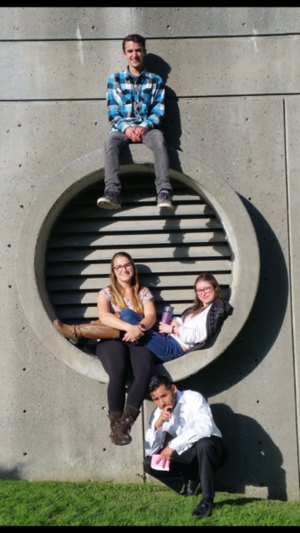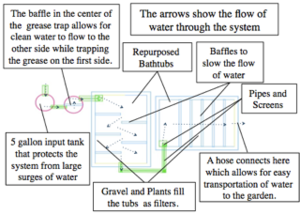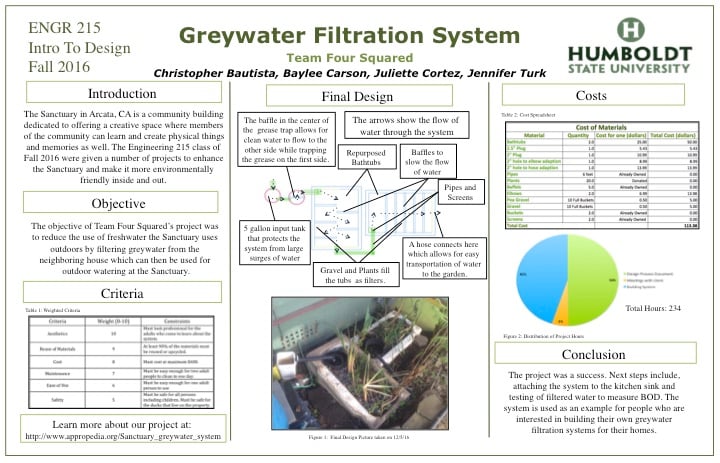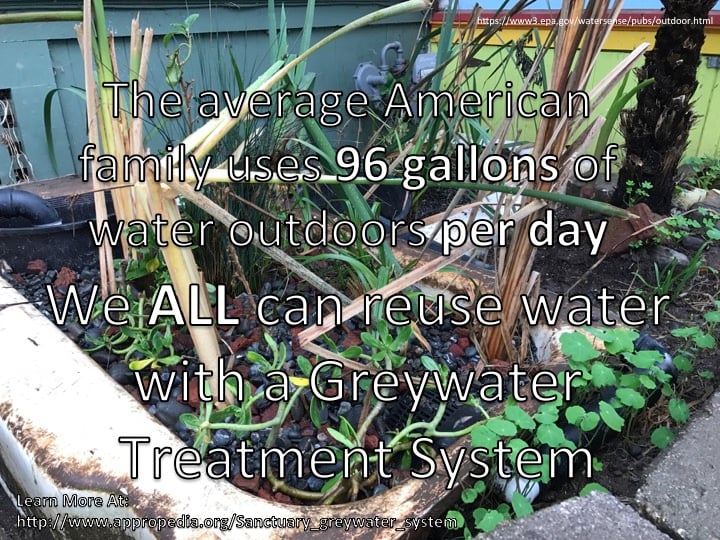No edit summary |
|||
| Line 42: | Line 42: | ||
== Description of final project == | == Description of final project == | ||
[[Image:Detailed EX GWsystem.png| thumb | right | Fig 1: Overview of CAD]] | |||
[[Image:Picture1.jpg|thumb|Fig 2: Overview of Greywater system]] | |||
This grey water system was build for The Sanctuary in Arcata by team FourSqaured. The purpose of this system is to save water by recycling it through biological filtration. Before our newly built system, The Sanctuary used unfiltered sink water to water their garden. This new system consists of a grease trap, two repurposed bathtubs and a hose attachment so that The Sanctuary can use filtered water to irrigate their garden. The objective of this project was to use the least amount of embedded energy when creating our project by using recycled materials. | This grey water system was build for The Sanctuary in Arcata by team FourSqaured. The purpose of this system is to save water by recycling it through biological filtration. Before our newly built system, The Sanctuary used unfiltered sink water to water their garden. This new system consists of a grease trap, two repurposed bathtubs and a hose attachment so that The Sanctuary can use filtered water to irrigate their garden. The objective of this project was to use the least amount of embedded energy when creating our project by using recycled materials. | ||
| Line 50: | Line 51: | ||
Tub Two : The water entering from tub one then drains into tub two where a similar set up as tub one is in place; however, smaller gravel and large rooted plants(e.g. blue iris) were used. Once the water travels to the opposite end of the tub, water flows out of the tub and through a connection where water can drain, or a hose can be attached. | Tub Two : The water entering from tub one then drains into tub two where a similar set up as tub one is in place; however, smaller gravel and large rooted plants(e.g. blue iris) were used. Once the water travels to the opposite end of the tub, water flows out of the tub and through a connection where water can drain, or a hose can be attached. | ||
===Cost Table=== | ===Cost Table=== | ||
Revision as of 00:34, 16 December 2016

Abstract
The purpose of this project was to build a greywater filtration system to reduce fresh water use and inspire other to create reusable water resources. Our client hosts large parties and events regularly meaning many people from the community spend time at the site. Our team made the system look as inspirational as possible so that when community members see it, it may inspire them to create one of their own. A "How To" Manual can be found below to allow others to recreate our system at their own homes. This system specifically filters water from two kitchen sinks, however, it can be modified to filter washing machine runoff or showers. Below is a description of the final project team four squared built at the Sanctuary.
Background
Team Four Squared is a group of Humboldt State University students who are a part of the Engineering 215 - Introduction to Design class of Fall 2016. Our client, The Sanctuary, located on J street in Arcata, CA is a community building dedicated to offering a creative space where members of the community can grow, create and build not just physical things but experiences and memories as well. This greywater system will serve not only as a water filtration station but also as inspiration for others to build their own greywater filtration systems.
Problem statement and criteria
The objective of this project was to reduce the amount of city water that the Sanctuary uses outdoors. Our system filters the kitchen sink water from the neighboring house allowing the Sanctuary to use recycled water for outdoor use. The recycled water that will be coming from our system will be primarily used for irrigating the sanctuary's garden.
| Criteria | Importance | Constraints |
|---|---|---|
| Aesthetics | 10 | Must look professional for adults who come to learn about the system. |
| Reuse of materials | 9 | 90% of the materials used must be reused or upcycled. |
| Cost | 8 | No more than $400 may be spent |
| Maintenance | 7 | The system needs to be able to be maintained by 2 adults. |
| Ease of use | 6 | The system needs to be able to be used by any one adult. |
| Safety | 5 | Must be safe for all persons including children. Also must be safe for the ducks that live on the property. |
Description of final project

This grey water system was build for The Sanctuary in Arcata by team FourSqaured. The purpose of this system is to save water by recycling it through biological filtration. Before our newly built system, The Sanctuary used unfiltered sink water to water their garden. This new system consists of a grease trap, two repurposed bathtubs and a hose attachment so that The Sanctuary can use filtered water to irrigate their garden. The objective of this project was to use the least amount of embedded energy when creating our project by using recycled materials.
Grease Trap : For this grease trap our team used repurposed plastic buckets that are placed side by side and connected by a 5" long pipe at the bottom. These buckets are side by side because the "wall" in between the buckets acts as a trap for grease. Water is coming from the sink, meaning there is a large amount of grease in the water. In the first bucket, where water enters from the house, a screen 5" in depth lies on the top of the bucket. Inside this screen are a few layers of straw and other grease absorbing plants/material. The point of this first bucket is to trap the grease on the top of the water where the plants/material can absorb the grease. Less greasy water then travels through the 5" long pipe into the second bucket. Once enough grey water fills the second bucket it will flow into the first tub for further filtration.
Tub One : Tub one contains ten five gallon buckets full of large gravel, four vertical baffles placed on opposite sides (see Fig 1), five different species of marsh plants were used for nutrient uptake and a planter bucket for ease of maintenance. The planter bucket provides ease of maintenance because a screen 5" deep in the bucket lies beneath the water outlet allowing for access of the pipe and screen. Water then percolates through holes in the planter bucket where further filtration occurs through gravel, baffles and plants. The baffles we used are cut out pieces of repurposed plastic bins. Baffles help to redirect and slow the movement of water. Plants are a huge component of this system, plants from the marsh were used since they have higher absorption rates of nutrients. The plants used were the following: Mugwort, Fuchsia, Succulents, Bulrush and Cattails. Water flows from the planter bucket to the overflow hole at the end of the tub. The overflow hole connects to a pipe that moves the water to tub 2.
Tub Two : The water entering from tub one then drains into tub two where a similar set up as tub one is in place; however, smaller gravel and large rooted plants(e.g. blue iris) were used. Once the water travels to the opposite end of the tub, water flows out of the tub and through a connection where water can drain, or a hose can be attached.
Cost Table
Total Costs of Grey water System:
| Quantity | Material | Source | Cost ($) | Total ($) |
|---|---|---|---|---|
| 2 | bathtubs | 25.00 | 50.00 | |
| 1 | 2.5" Plug | 5.43 | 5.43 | |
| 1 | 2" plug | 10.99 | 10.99 | |
| 1 | 2" hole to elbow adapter | 8.99 | 8.99 | |
| 1 | 2" hole to hose adapter | 13.99 | 13.99 | |
| 6 | 1 foot long 2" wide pipe | 0.00 | 0.00 | |
| 20 | Plants | 0.00 | 0.00 | |
| 6 | baffles | 0.00 | 0.00 | |
| 2 | elbow pipes | 6.99 | 13.98 | |
| 10 | 5 gal pea gravel | 0.50 | 5.00 | |
| 10 | 5 gal larger gravel | 0.50 | 5.00 | |
| 2 | screens | 0.00 | 0.00 | |
| Total Cost | $113.39 | |||
Testing Results
The Sanctuary will not be using this system during the winter. So in February we will have more data. This video describes how the water would flow if the system was working properly.
How to build
This section gives a step by step explanation on how to build this system, explaining piping and materials used.
Maintenance
It is important to properly maintain this system otherwise it may not work properly. The majority of time maintaining this system is only done every few years, with small amounts of cleaning on an as needed basis.
Schedule
This maintenance schedule will provide steps that can be taken on a daily,weekly,monthly,and yearly basis to ensure proper functionality of the system.
- Daily
- Check for clogs or build up in the input tank, empty and wash out the filter as needed (3 min).
- Check for clogs or leaks in the outputs of tub 1 and 2, empty and wash out as needed (2-10 Min).
- Weekly
- Take out any plants that may have died as needed(2 min).
- Clean out any build up that may have formed in the input buckets of tub 1 and tub 2 (5 min).
- Replace the hay filter in the input tanks and remove excess grease (5 min).
- Monthly
- Check to make sure there isn't any build up of debris in the pipes of inputs (5 Min).
- Yearly
- Replace any buckets or pipes that may have been broken or cracked during the winter months
- Every 3 years
- Run copious amounts of water through the rocks and plants to clean out all of the nutrients and debris that have formed over time (1 hour).
- If necessary replace any rocks, buckets, or pipes that need to be replaced due to damage or malfunctions (1 hour).
Troubleshooting
This is only how to troubleshoot basic operation.
| Problem | Suggestion |
|---|---|
| Water is not flowing freely through the system | Check for clogs and debris buildup in the output pipes of tub 1 and tub 2. |
| There is a clog in the piping | After knowing where a blockage is present. You have to disassemble the pipes connections using a flat head screw driver to be able to remove the blockage. |
| The system has objectionable odors | Run enough water through the system to ensure the system's water is not still |
Discussion and next steps
- Connect the grey water system to the drain of the sink inside the house.
- Attach a garden hose to the overflow water outlet of tub 2 so plants can be watered with the greywater in the system.
- Allow the roots of the plants in grey filtration system to grow to better absorb nutrients in the greywater
- Use the system to inspire spectators in ways to conserve water and live sustainably
- The system will not be connected to the sink until February 2017

